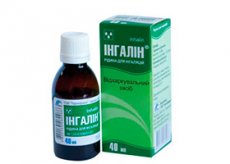Medical expert of the article
New publications
Preparations
Inhalin
Last reviewed: 03.07.2025

All iLive content is medically reviewed or fact checked to ensure as much factual accuracy as possible.
We have strict sourcing guidelines and only link to reputable media sites, academic research institutions and, whenever possible, medically peer reviewed studies. Note that the numbers in parentheses ([1], [2], etc.) are clickable links to these studies.
If you feel that any of our content is inaccurate, out-of-date, or otherwise questionable, please select it and press Ctrl + Enter.

Indications Ingalina
It is used in the combined treatment of respiratory diseases (in acute form) affecting the upper respiratory system, as well as tracheitis with pharyngitis, pneumonia and bronchitis.
Release form
The product is produced in the form of an inhalation liquid, in 40 ml bottles. The package contains 1 such bottle.
Dosing and administration
Adults undergo inhalations, which use 10-20 drops of the medicine, which are diluted in plain warm water (0.2 l, 1 glass). For children over 3 years old, it is necessary to add 5-10 drops of the drug to the water.
The procedures should be performed 3-4 times a day. The duration of the treatment course is selected by the attending physician, taking into account the drug effectiveness and the patient's condition.
Use Ingalina during pregnancy
The use of Ingalin during lactation or pregnancy is permitted only after the doctor has carefully assessed the benefit-risk ratio of its use.
Side effects Ingalina
The medication is often tolerated without adverse effects, although allergic symptoms sometimes develop, including skin rash, redness, and itching. Contact dermatitis sometimes occurs around the lips, as well as urticaria, angioedema, apnea, laryngospasm, and bronchospasm.
If side effects are severe, the use of the drug should be discontinued.
Overdose
Long-term use of Ingalin in high doses can lead to dizziness, muscle weakness, nausea, a feeling of confusion, and diplopia.
If such disorders occur, the use of the drug is discontinued. Symptomatic measures are also carried out.
 [ 15 ]
[ 15 ]
Shelf life
Ingalin can be used for 3 years from the date of manufacture of the drug.
Application for children
It is prohibited to prescribe to children under 3 years of age.
 [ 18 ]
[ 18 ]
Analogues
The following drugs are analogs of the medication: Mucaltin with Licorice, Prospan and Pertussin, as well as Gedelix, Fitobronchol and Eukabal with Bronchipret.
 [ 19 ], [ 20 ], [ 21 ], [ 22 ]
[ 19 ], [ 20 ], [ 21 ], [ 22 ]
Reviews
Ingalin is considered to be a fairly effective drug. In reviews, patients indicate that it copes well with the disorders specified in the instructions, acts quickly and with good results. In addition, the drug is inexpensive, as well as simple and easy to use.
Attention!
To simplify the perception of information, this instruction for use of the drug "Inhalin" translated and presented in a special form on the basis of the official instructions for medical use of the drug. Before use read the annotation that came directly to medicines.
Description provided for informational purposes and is not a guide to self-healing. The need for this drug, the purpose of the treatment regimen, methods and dose of the drug is determined solely by the attending physician. Self-medication is dangerous for your health.

